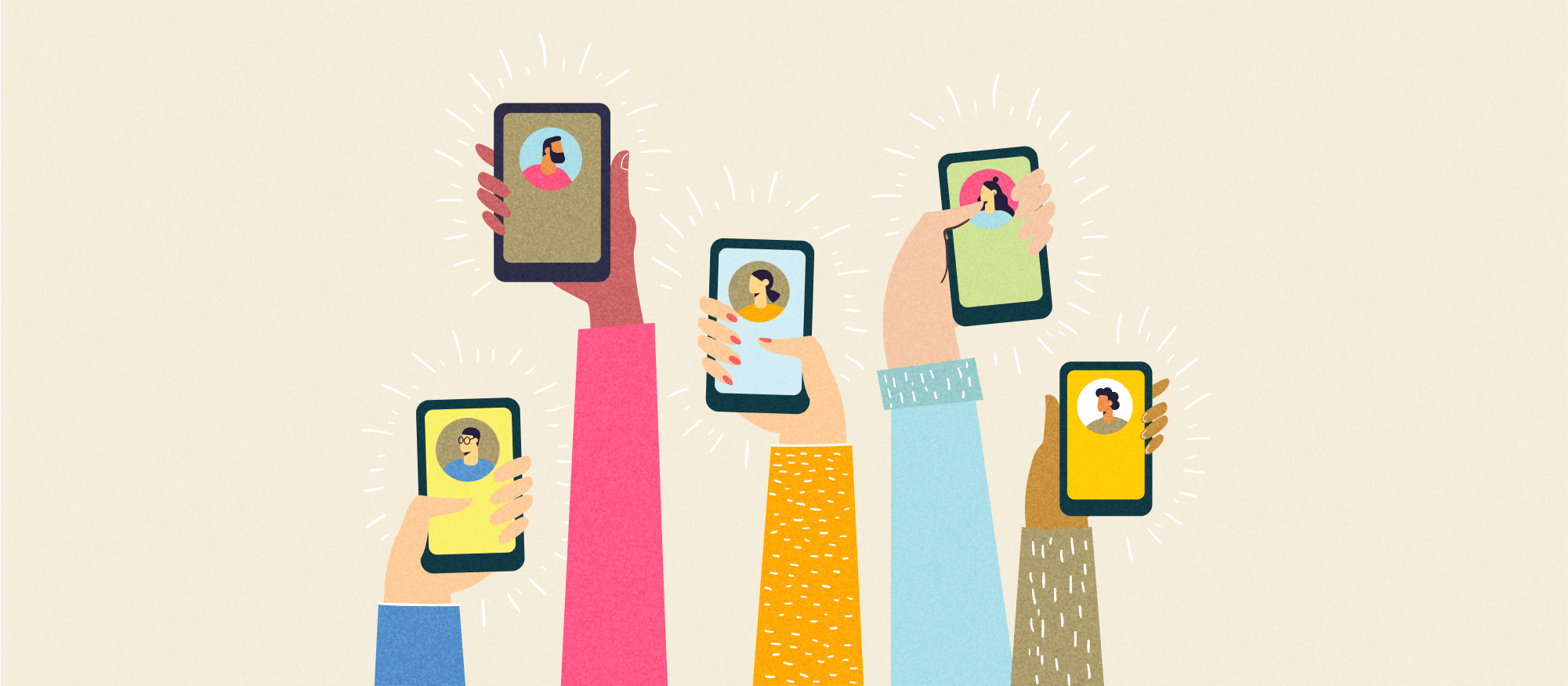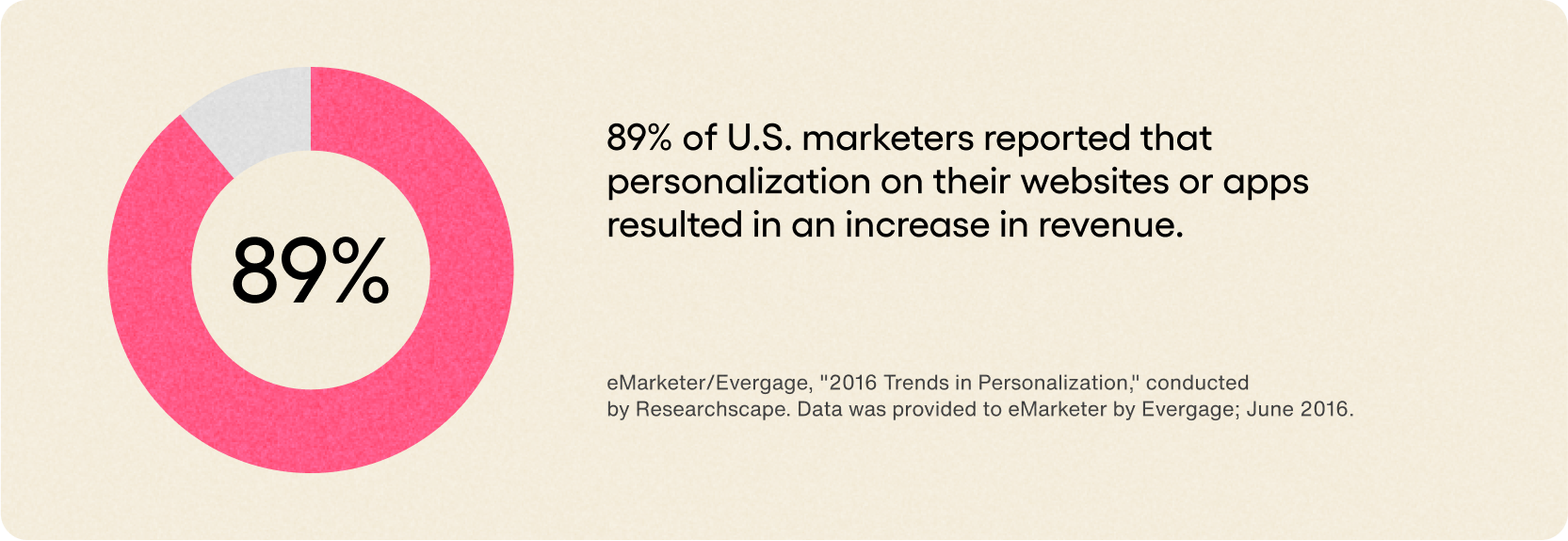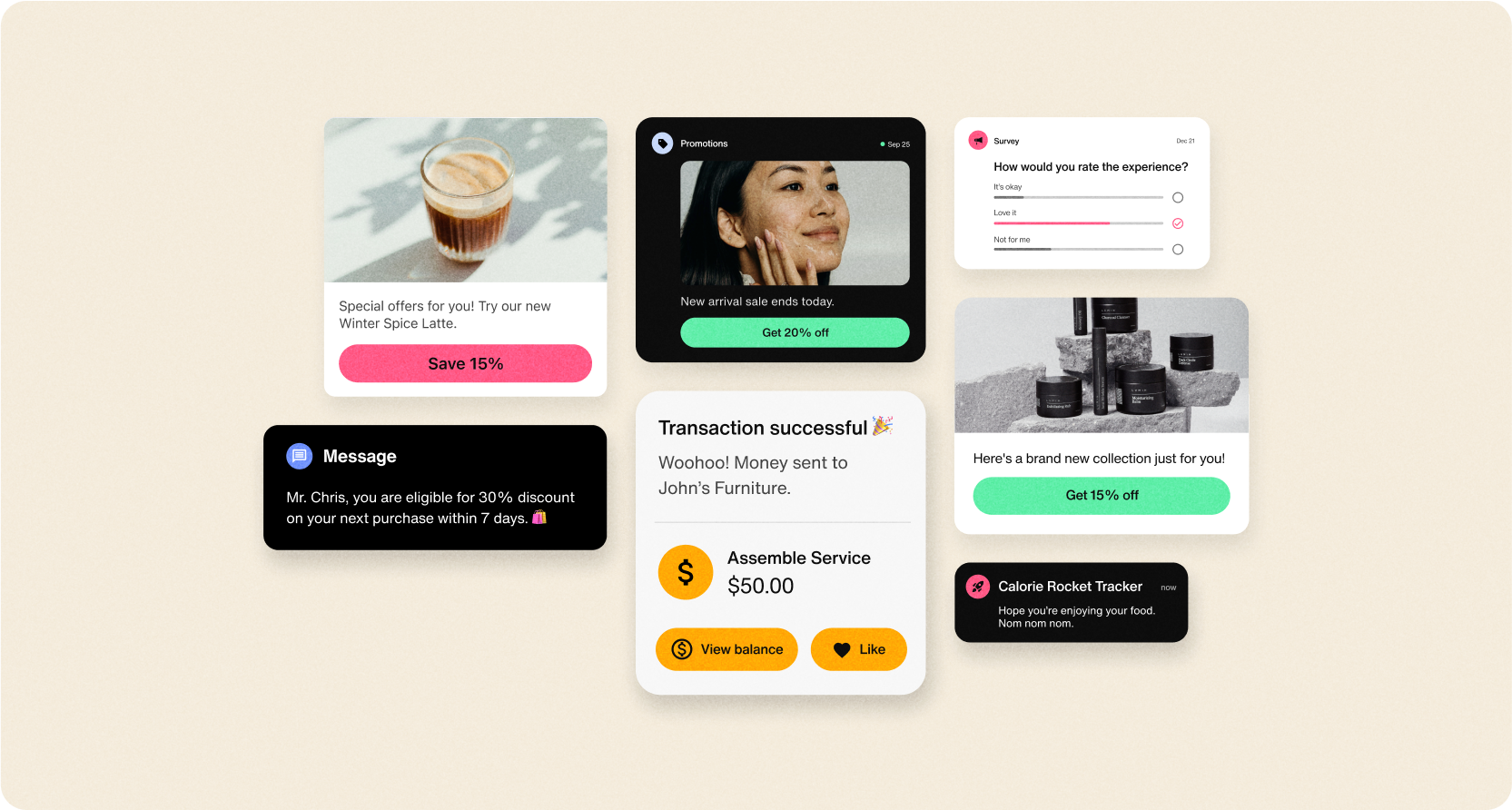Tailoring app experiences with personalization

Personalization is one of the best ways to engage and build trust with mobile app users. According to McKinsey, 71% of consumers expect companies to deliver personalized experiences.
76% of consumers get frustrated when personalization doesn’t happen.

Research shows that 89% of marketers reported that app personalization resulted in an increase in revenue. By putting the customer at the center of the mobile app journey, personalization makes them feel included and that you understand and care about their needs. A tailored customer experience drives customer satisfaction, user engagement and loyalty, and grows customer lifetime value.
In this post, we’ll explain how mobile app personalization works and how you can improve your personalization efforts.
What is personalization?

Personalization is tailoring messages and customer experiences based on individual customers’ expectations, preferences, and needs. It goes beyond simply calling your customers by their first name. It includes every element that goes into providing a unique experience tuned into what customers want.
When done right, personalization improves customers’ well-being, anticipates and meets their needs, and increases customer loyalty. It directly and indirectly influences customer buying behavior across the customer lifecycle. For example, consumers are 76% more likely to buy from personalized brands. They’re also 78% more likely to make repeat purchases and more likely to refer friends and family to companies that personalize the customer experience.
Mobile app personalization delivers each user a unique experience customized to their specific needs. It involves designing a user experience and creating in-app messaging around user data – interests, demographics, location, and behavior. Personalization builds trust and engagement by providing precisely what users want and need.
Note that personalization differs from customization. Customization is when users can create their own personalized experience. Personalization is when the app or business provides a unique, tailored user experience.
What does personalization look like in-app?
Your personalization strategy aims to provide a tailored experience at every touchpoint in the customer journey so users feel included, engaged, and understood.
Let’s look at some benefits:
Better user experience
Personalization enhances the user experience, which drives sales growth. Over 91% of customers say they prefer to shop with brands that provide offers that apply to them, and 74% say they are likely to buy based on customer experience alone.
Improved user retention and engagement
Providing personalized user experiences drives user retention and engagement. Over half (59%) of consumers say past personalized experiences are very important to winning their return business, and loyal returning customers are likely to spend 31% more.
More in-app conversions
Delivering personalized offers and messages increases the chance of users converting. As we mentioned, 89% of marketers reported a revenue increase from app personalization, and 63% of smartphone users are more likely to purchase from apps that deliver personalized product offerings.
In-app personalization comes in several forms. Personalized in-app elements can include:
User interface (UI) design
Push notifications
Product recommendations
Special offers
In-store discounts
Loyalty programs
Onboarding
Omnichannel messaging
Content personalization
But that’s only the tip of the iceberg. If you have the right user data, you can design or customize every aspect of the app experience to meet users’ needs. Let’s look at some examples of personalization based on users’ demographics, location, interests, and behavior.
Using data from customer profiles
Customer profiles are one of the richest sources of user data for personalization. You can use this data to tailor the app experience and in-app messaging users’ personal information, tastes, and preferences.
Few things are as personal as dating, and dating app Hinge takes dating very seriously. Hinge’s goal is to help users truly connect and build meaningful relationships. They provide a highly personalized and engaging user experience to help users safely connect, build chemistry, and (hopefully) develop long-term relationships with compatible matches.
Central to Hinge’s user experience are its personalized chat and in-app messaging features to help users safely connect and determine if they have chemistry. It uses 1-on-1 messaging, push notifications, typing indicators, read receipts, user-to-user blocking, and rich media to let users build trust and feel safe before meeting in person.
Geolocation
Over 97% of companies worldwide use location-based information to personalize user experiences, reach customers, and provide better customer service. Mobile app geolocation is designing your app to reflect users’ location, language, culture, and time zone. Geolocation personalizes your app by making it intuitive and accessible to users worldwide.
For example, by incorporating mobile app location into your onboarding process, you can design your app so that it greets users in their native language.
Mobile app location also lets you present users with localized messaging and offers. Hostelworld provides travelers with hostel accommodation options with over 16,500 hostels globally. Over half of Hostelworld’s users are solo travelers, and one of the main reasons they use Hostelworld is to meet other travelers along the way. Hostelworld’s app features an in-app chat feature that connects users traveling in the same city or region. If the users are staying in the same hostel, the app automatically invites them to the hostel’s local chat.
Time of day
Time of day personalization lets you send in-app notifications and messages to users when they’re most likely to see and engage with them. For instance, if you have a shopping app and know users are more likely to make purchases in the early evening, you could send them personalized promotions or discounts then.
Interaction and purchase history
Customers are 78% more likely to make repeat purchases from online retailers that personalize their customer experience. You can build engagement with users by sending them personalized content and offers based on their past purchases or interactions with relevant content and communities. Because they are already familiar with their brand, customers are much more likely to engage with and accept personalized offers.
Singapore-based e-commerce provider Carousell is one of the biggest and fastest-growing classified marketplaces in South East Asia. They feature over 196 million listings and have successfully transacted over 71 million items. Carousell’s “Recommended For You” section offers real-time targeted listings based on the user’s preferences and past purchases. As users continue to shop on the app, the level of personalization increases.
Time in app
You can monitor how long a user stays engaged with the app and its features and use that information to send them personalized recommendations and notifications. The classic example of time-based personalization is the cart timer–if a customer abandons a cart, the app sends a notification reminding them they still have pending purchases. Another classic example is mobile gaming, where games reward users for spending time in the app by sending messages, achievements, or gifts.
These examples only offer a glimpse of the vast potential of app personalization. Whenever you customize the user experience or in-app messaging based on user information, you use personalization.

Build in-app messaging with developer-friendly SDKs, APIs, and UIKits.
How to personalize customer experience in-app
You can improve engagement by improving each touchpoint of your mobile app customer journey with personalization. The key to personalization is to act on user data and understand your customer’s needs and preferences. Follow these tips to get started.
Choose and collect user data
The first step is to understand your users’ preferences and needs at each user journey stage. That means collecting and analyzing relevant user data, and using it to guide the development of personalized elements.
There are three different types of user data you can collect:
Demographic data that tells who your users are. This data includes personal information like age, gender, likes & dislikes, and occupation. The easiest way to collect demographic data is to ask your customers during onboarding and account creation.
Contextual data includes your users’ location, device type, or time of day.
Behavioral data that tells about users’ in-app or online behaviors. This data includes time spent in the app, what features they use, how users interact with the app, past purchases, time since last visit, and videos/content viewed.
Once you’ve collected the user data, you can analyze it to identify patterns and group similar users by demographics, context, and behaviors.
It’s important to consider data privacy when you’re collecting personal data. Be transparent about data collection and how you will use customer data. Customers may exchange their personal information for a better user experience, however, you shouldn’t infringe on their privacy. You should also follow privacy regulations such as the GDPR and CCPA.
Offer unique and tailored experiences
After you’ve collected user data, you can use it to personalize your app's user touchpoints and interactions. Design and optimize your app by considering your customers’ demographic, location, and behavior data to make the user experience more relatable.
For example, you could add or highlight “most used” features or content, similar to how Spotify includes user’s favorite music genres in their daily music mix and other listening features. The more tightly you match the app design to customers’ preferences, the more likely they will engage with the app.
Send push notifications and in-app messages
Sending personalized messaging and notifications are powerful ways to engage users. Sending and sharing relevant and timely communications with users increases retention and conversion rates. For example, personalizing push notifications increases user reaction rates to 9% (from an average of 4% for non-personalized push notifications). Tailoring send times improves push notification reaction rates by 40%.
Include personalized in-app communication features like chats, chatbots, push notifications, in-app messages to enhance the feeling of a personal user experience. Also, consider making personalized in-app messaging part of an omnichannel marketing strategy via personalized email marketing, SMS, FAQs, web pages, forums, and social media to engage your users across other channels.
Optimizing the user onboarding process
Onboarding is a crucial stage of the user journey. The average Day One retention rate for mobile apps is 25.3%, meaning three out of four users delete your app the same day they download it. Personalized elements can increase new user engagement past Day One–for example, personalized in-app messaging can boost retention by 30%.
Create a personalized onboarding experience that engages users when they open their app. Even something as simple as welcoming new users by name can improve engagement. You can also increase engagement by identifying and welcoming new users by use case. For example, meditation app Headspace greets new users with an interactive questionnaire that helps them think about why they are meditating and set personal goals for meditation.
Experiment and optimize
Even with the best user data, you probably won’t get a perfect personalization experience on the first try. Personalization takes time, so you’ll need to test different personalization elements to see what works and what doesn’t.
Use A/B testing to understand what messaging or tailored elements work best for users. Customer feedback and support interactions are also a great way to learn how users are interacting with your app. Use the test results to tweak your app, then test again. Personalization is a continual process of adapting, testing, and changing your app as it matures and your user base evolves.
When you’re ready to personalize your app, begin with user metrics and analysis. Protect user privacy, offer tailored messaging and user experience, and test and optimize your app. And when it’s time to create effective in-app messaging and user engagement elements, Sendbird can help.
Empower app personalization with Sendbird
Personalizing your app takes a focused effort across multiple touchpoints and technologies to truly make your customers feel engaged and understood.
Sendbird is an ideal partner to help you add that extra gloss.
Innovative brands around the world boost engagement, conversions, and CSAT with Sendbird's conversations platform. Build personalized social, marketing, and support chat into your app in a way completely customized to your brand goals.
Ready to get started with Sendbird? Try Sendbird for free for 30 days, or talk with our sales team.










